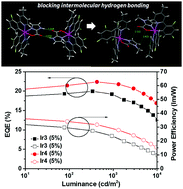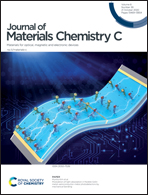New blue phosphorescent heteroleptic Ir(iii) complexes with imidazole- and N-methylimidazole carboxylates as ancillary ligands†
Abstract
Imidazole- and N-methylimidazole carboxylate have been introduced to serve as ancillary ligands in heteroleptic Ir(III) complexes containing 2-phenylpyridine-based main ligands, with consideration of the frontier orbital energy levels. Complexes Ir1–Ir4 were synthesized and found to have LUMO levels higher than that of the corresponding Ir(III) complex containing pyridyl carboxylate. All the synthesized Ir(III) complexes exhibited blue phosphorescence emission maxima in the region of 465–467 nm at room temperature. Phosphorescent quantum efficiencies were increased by a factor of 1.8–6.7 by blocking the intermolecular hydrogen bonding between the imidazole carboxylate ligands of neighboring Ir(III) complexes, which was achieved by N-methylation of the imidazole carboxylate ancillary ligand. The organic light-emitting diodes fabricated using Ir3 and Ir4 as dopant materials in the emissive layers were found to emit blue emission with peaks at 469 and 471 nm and maximum external quantum efficiencies of 20.0 and 22.4%, respectively. Moreover, all the fabricated devices with Ir3 and Ir4 exhibited low efficiency roll-off, indicating excellent stability of the materials.



 Please wait while we load your content...
Please wait while we load your content...